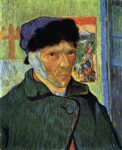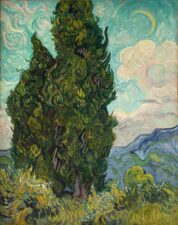
Vincent Van Gogh
Dutch, 1853-1890 (active France)
Hospital at Saint-Rémy, 1889
oil on canvas
36 5/16 × 28 7/8 in.
The Armand Hammer Collection, Gift of the Armand Hammer Foundation. Hammer Museum, Los Angeles

Van Gogh - Self-Portrait with Bandaged Ear, January 1889
“I also have two views of the park and the asylum in which this place appears most agreeable. I tried to reconstruct the thing as it may have been by simplifying and accentuating the proud, unchanging nature of the pines and the cedar bushes against the blue.” – Letter to Theo, 8 October 1889

Cypresses, 1889, oil on canvas, 36¾ × 28¾ in.
COMMENTS
In this peaceful, supple valley, far from the storms of Paris, surrounded by the fantastical shapes and meandering lines of the Alpilles, Vincent conceived a new notion of line and form. “When the thing represented is, in point of character, absolutely in agreement and one with the manner of representing it," he suggested after one of his first outings, “isn’t it just that which gives a work of art its quality?" Not only should “color” express the essence of the subject depicted (earth tones for the peasants of Nuenen, red and green for the lonely denizens of the night cafe); so, too, the “form” should reflect the subject’s true nature, not just its outward appearance. And what could be more “in agreement” with this enchanted valley and its fairy-tale mountains than an art of exaggerated forms and playful lines? …
In this enchanted valley, everything has a life of its own. Even the stone wall that enclosed the field outside Vincent’s window seems to merge into the living landscape. Its angles soften; its hard edges melt. Instead of hewing to its straight course, it wanders across the undulating ground like a country lane or a hedge-row, as much a part of the countryside as the furrows and fields it encloses. Vincent was convinced that his old comrades Bernard and Gauguin would approve his new, “more spontaneous drawing." “They do not ask the correct shape of a tree at all,” he insisted. But, in fact, nothing could have been further from either Gauguin’s ambitious striving after Degas’s or Bernard’s cerebrated ornamentalism than Vincent's tranquil, childlike world outside the world.
That world would not have been possible without brushstroke. “What an odd thing the touch, the stroke of the brush, is," he wrote in newfound wonderment. By altering the brushstroke “in keeping with the subject,” he discovered, “the result is without doubt more harmonious and pleasant to look at, and one can add whatever serenity and happiness one feels." Freed from the “isms” that had chained it for so long, Vincent’s hand now returned to his Hague quest (kept alive since in drawings and letter sketches) to find the perfect fit of subject, line, texture, and mood. He cited the great engravers Félix Bracquemond and Jules Lacquemart, who had transformed works of art from one medium (oil) to another (copper plate) and in the process given them new perfection. He would do the same for nature, using the distinctive marks of “his” medium: brushstroke.
To practice this “fit,” he found the ideal subjects right in plain sight, where he had looked past them a thousand times: cypress trees.
They grew everywhere in the valley, some dating back to Roman times. They served as windbreaks and grave markers; they lined roads and marked boundaries; they stood in cohorts and in lonely sentinel. Once he saw them, their compact, “bottle-green" foliage and plain conical shape captivated him. He compared them in “beauty of line and proportion" to Egyptian obelisks. “The cypresses are always occupying my thoughts," he wrote. “I should like to make something of them like the canvases of the sunflowers, because it astonishes me that they have not yet been done as I see them.”
He saw them not just as simple cones (“a splash of black in a sunny landscape”), but as constellations of strokes. Like an astronomer looking through a telescope, the more closely he looked, the more he saw—and the more his brush recorded. From a distance, the dense branches all curved toward the pointed tip, twisting and flickering upward like flames. But as he approached closer and closer, each quivering branch became a little spiral of color and motion. Some curled upward, advancing the tree toward the sky; others flung themselves outward into space. Branch by branch, spiral upon spiral, he patiently piled them up, transforming ancient monuments of nature into towering monuments of paint.
By the end of the month, Vincent was working on a dozen canvases at once—almost all of them featuring cypress trees. Another dozen sat in the dormitory doorway, drying in the June heat. One of these was a nighttime study of a single tree silhouetted against a strange celestial display. "Finally", he wrote Theo, “I have a new study of a starry sky. "
- Steven Naifeh and Gregory White Smith, Van Gogh: The Life, New York: Random House, 2011, 757-759
SBMA CURATORIAL LABELS
Van Gogh entered the psychiatric clinic in Saint-Rémy in May 1889. By September, he was well enough to be looking forward to the autumn landscapes that he hoped to paint around the hospital, including this one, in which, as he put it “I tried to reconstruct the thing as it may have been by simplifying and accentuating the proud, unchanging nature of the pines and the cedar bushes against the blue.”
Though there are diminutive figures strolling in the foreground, the principal characters of this composition are the trees themselves. As in Japanese and Chinese ink painting, the trees are anthropomorphized, exuding the stately demeanor of long-time residents of an ancient landscape. Van Gogh exaggerates the uppermost limbs of the trees cropped to either side, so that their proportions generate a looming sense of monumentality as compared to the tiny figures below. This directional movement towards the upper register of the composition is reinforced by the energy of the repeated brushstrokes intermingling trees and sky.
- Through Vincent's Eyes, 2022
